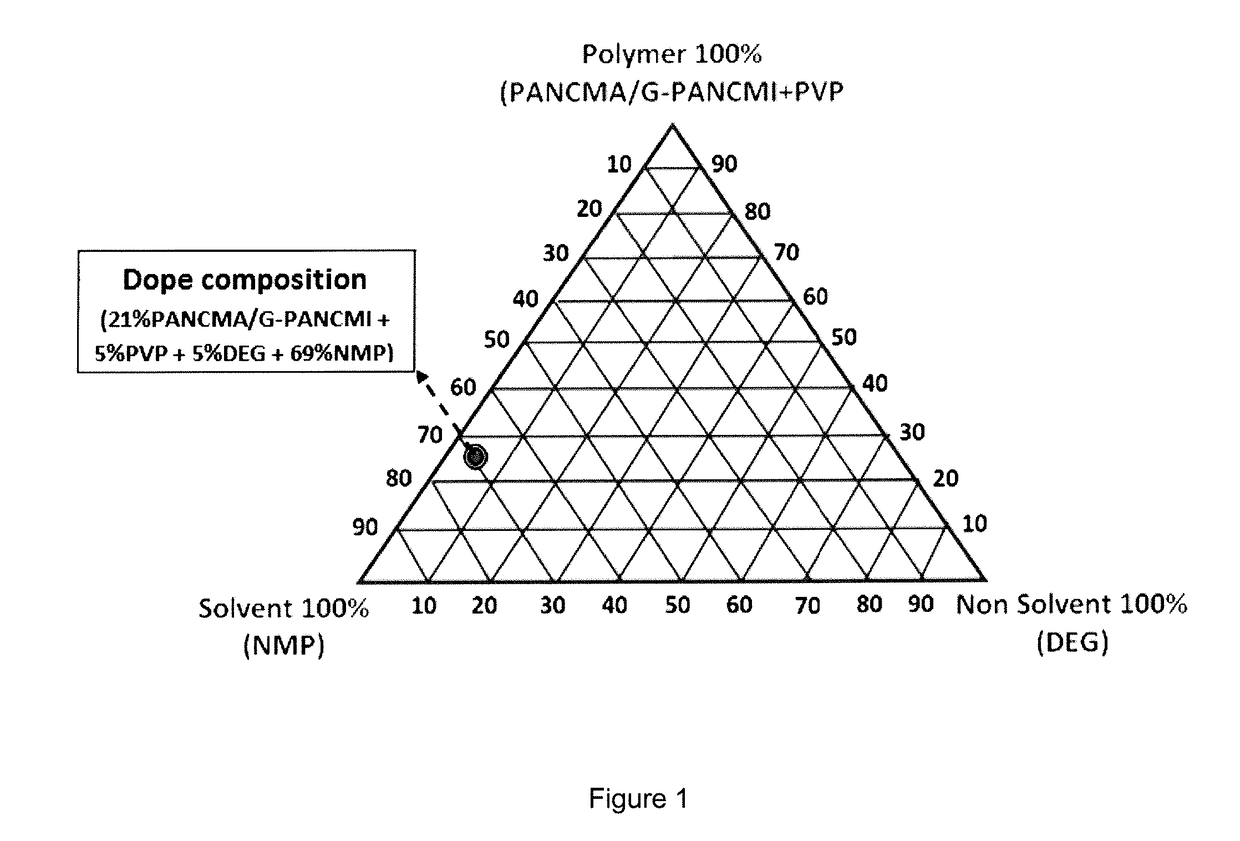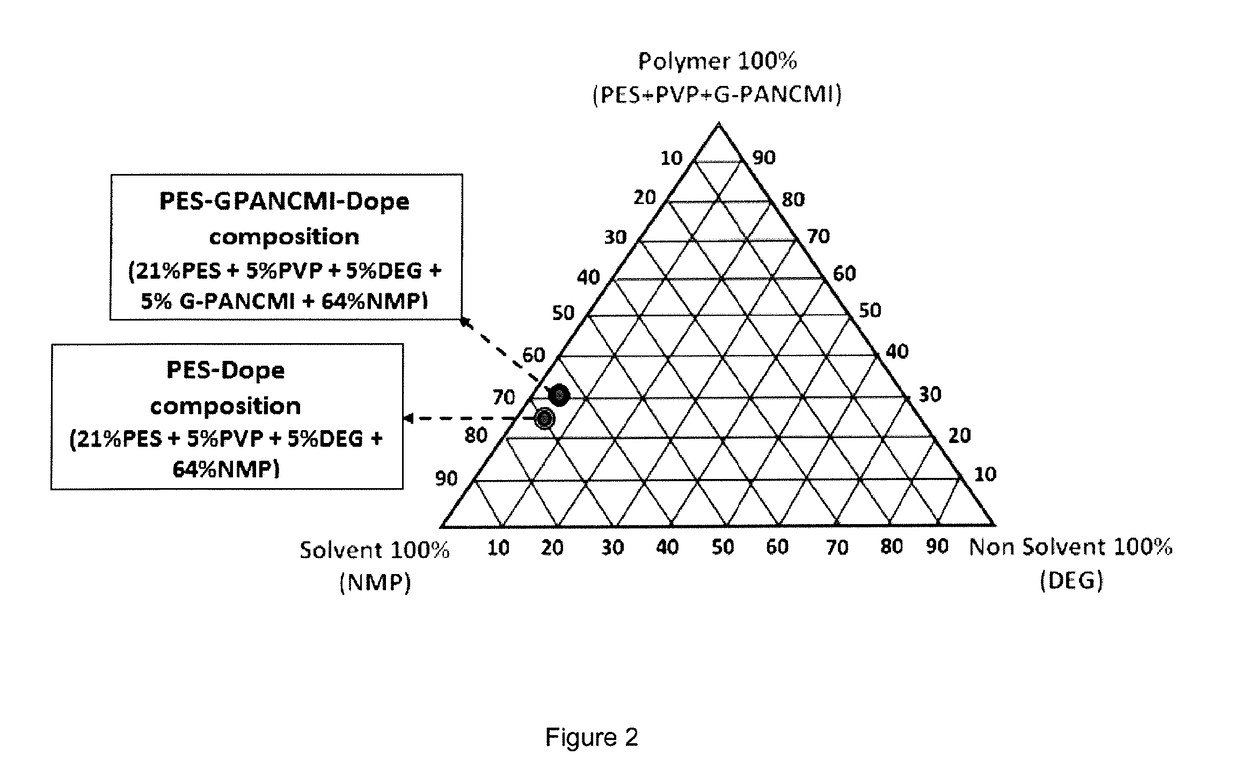Graphene-based membrane and method of producing the same
- Summary
- Abstract
- Description
- Claims
- Application Information
AI Technical Summary
Benefits of technology
Problems solved by technology
Method used
Image
Examples
example 1
Synthesis of Functionalized Graphene
[0094]About 1 g of pristine graphene was pre-treated with an excess of acid mixture (comprising sulphuric acid / nitric acid in a ratio of 3:1) to introduce the acid functionality onto the graphene surfaces. This step was carried out at a temperature of about 55° C. to 85° C. for 19 to 29 hours. After successful oxidation, the functionalized graphene was centrifuged, filtered and washed with excess water until the pH of the wash water was neutral. The acid functionalized graphene was thoroughly dried and further refluxed with 150 ml thionyl chloride at a temperature ranging from 60° C. to 80° C. for about 19 to 29 hrs. Excess thionyl chloride was then filtered off before 150 ml of ethylene diamine was added to the reaction vessel, operating under reflux at a temperature ranging from 60° C. to 80° C. for another 19 to 29 hrs to obtain an amine functionalized graphene. The amine functionalized graphene was then separated out by centrifugation and wash...
example 2
Synthesis of Graphene Grafted Poly(Acrylonitrile-Co-Maleimide) (G-PANCMI)
[0095]Poly(acrylonitrile-co-maleic anhydride) (PANCMA) was prepared by having both acrylonitrile and maleic anhydride (1:1 molar ratio) dissolved in N—N Dimethyl acetamide in presence of azobisisobutyronitrile as an initiator. The solution was stirred at room temperature for about 24 hours to obtain a poly(acrylonitrile-co-maleic anhydride) in solvent. The mixture was then filtered and washed with ethanol, and dried at 60° C. to 80° C. for 7 to 17 hours to obtain the poly(acrylonitrile-co-maleic anhydride) (PANCMA).
[0096]The synthesized poly(acrylonitrile-co-maleic anhydride) (PANCMA) was allowed to react for about 24 hrs with the amine functionalized graphene (obtained in Example 1) in 500 ml of N—N-dimethyl acetamide (DMAc) at 80° C. This reaction leads to the formation of a graphene grafted poly(acrylonitrile-co-maleic acid (G-PANCMA) in amic acid form. This intermediate product was further subjected to ther...
example 3
Preparation of Flat Sheet Membrane
[0097]Graphene grafted poly(acrylonitrile-co-maleimide) (G-PANCMI) membrane was prepared using simple phase inversion method. In this example, the graphene grafted poly(acrylonitrile-co-maleimide) (G-PANCMI) was used as the base polymer, N-methyl-2-pyrolidone (NMP) was used as a base solvent, diethylene glycol (DEG) was used as a non-solvent and polyvinylpyrolidone (PVP) was used as an additive (pore forming agent), to form a casting solution. The casting solution in this example consists of 21 wt % G-PANCMI, 5 wt % polyvinylpyrolidone (PVP-K-30), 5 wt % diethylene glycol (DEG), and 69 wt % N-methyl-2-pyrolidone (NMP). The phase diagram of the dope composition obtained in this example is as shown in FIG. 1.
[0098]The casting solution was prepared by first adding PVP powder into the NMP / DEG mixture in a round bottom flask. The solution was stirred by a mechanical stirrer for at least 1.0 to 1.5 hrs.
[0099]After the PVP was completely dissolved in the s...
PUM
| Property | Measurement | Unit |
|---|---|---|
| Temperature | aaaaa | aaaaa |
| Temperature | aaaaa | aaaaa |
| Temperature | aaaaa | aaaaa |
Abstract
Description
Claims
Application Information
 Login to View More
Login to View More - R&D
- Intellectual Property
- Life Sciences
- Materials
- Tech Scout
- Unparalleled Data Quality
- Higher Quality Content
- 60% Fewer Hallucinations
Browse by: Latest US Patents, China's latest patents, Technical Efficacy Thesaurus, Application Domain, Technology Topic, Popular Technical Reports.
© 2025 PatSnap. All rights reserved.Legal|Privacy policy|Modern Slavery Act Transparency Statement|Sitemap|About US| Contact US: help@patsnap.com



